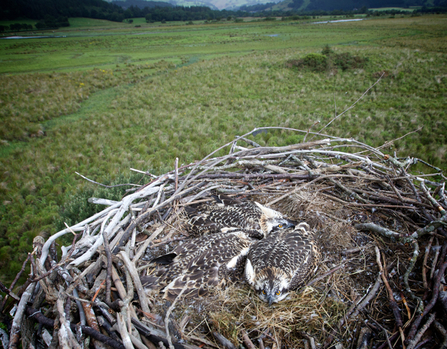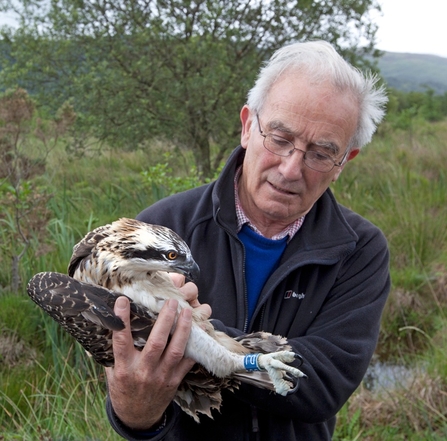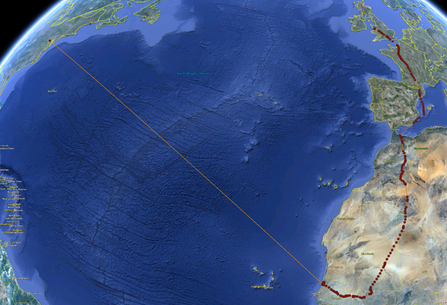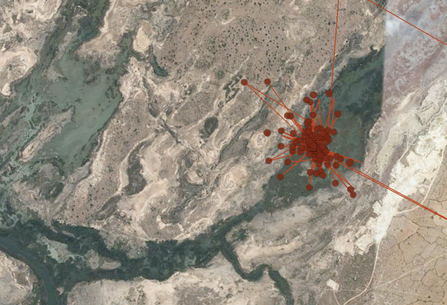Leri is quite an enigma. From the very moment she clambered out of her egg on this day last year, she has been full of surprises. The fact that she hatched at all was puzzling given that the incubation times of the eggs last year were so late. Here is the first sight of Leri we ever got on June 7th last year - the other two little ospreys you can see to her left are her brothers, Einion and Dulas.
Leri - Happy Birthday
Leri grew up to be a feisty, food-loving osprey with an attitude. She took no prisoners and always stood up for herself, often ending in squabbles with her older brother, Dulas. She was the last of her family to migrate on September 13th - Monty had left two days earlier, 408 fish caught in a season was enough for him. Leri missed the worst of the storm that blew Dulas off course the day before, but she still got caught up in some strong winds. Instead of heading south she was blown south-east and flew directly over Chichester before starting her channel crossing over Bognor Regis.
Leri (looking this way) with her two brothers in her Dyfi nest, all three chicks beautifully camouflaged

We had high hopes that Leri would reach Africa safe and well. She weighed 1610g when Roy Dennis and Tony Cross weighed and ringed her on July 19th - a good healthy weight for a female osprey that age. Her Darvic ring was put on her right leg (left leg in Scotland) - Blue DJ.
Roy confirms that Leri is in excellent condition at six weeks old

It was no surprise, then, that in just two weeks after leaving the Dyfi estuary, Leri had flown over 3,000 miles and had reached west Africa. She was, however, 450 miles inland so over the next week and a half she slowly but surely flew west, heading towards the Senegalese coast.
Then, on the last day of October 2011, her transmitter stopped sending signals back. Our friend Frederick who lives in St. Louis, Senegal, spent many days looking for Leri last November and December but to no avail. There was nothing to be found where the tracker last sent its transmission. We simply did not know whether the tracker had stopped working or whether Leri had died. Then, six months later, the most unusual thing happened - Leri's tracker started sending signals again - from America!
Could Leri have flown all the way over the Atlantic over the winter?

The signals started showing up on April 12th and were coming from Maryland, USA. We were thinking all sorts - boats, ships, oil tankers (it has happened before), floating wood. Surely Leri could not have made it that far over the ocean - then it dawned on us. The position of the tracker was exactly in the same position as the laboratories where they make the 30g osprey trackers. A quick phone call to Microwave Telemetry, who make the units, confirmed what we had been thinking. Leri's tracker number had been deleted and re-assigned to a brand new unit which was being tested for solar efficiency on a sunny Maryland roof. It wasn't Leri at all, it wasn't her tracker either. Back to square one.
Then, around a month ago, we started getting more signals, this time from Africa. In fact, they were coming from the same area that Leri was at when she sent the last transmission all of those months back in October. They were poor quality signals to start with - many showing 'low voltage' and 'low battery'. Then the signals got stronger and stronger until they were sending proper data about position, altitude and speed. Is Leri still alive?
Leri's tracker has been sending valid data since mid May, what does this data mean?

The GPS points show movement, not much, they are all within one square mile, but movement nonetheless. There also seems to be two or three main locations within the scatter of points where the tracker seems to go back to time after time. If Leri was dead, why would the tracker (a) keep moving around and (b) return to two or three base points?
The data, actually, invites more questions that it does answers. Would an osprey really be in the same spot as she was eight months ago? Why isn't she moving more than a few hundred metres (800m maximum from the centre). Why has the tracker suddenly started working all these months after quitting? Has the return of the rains turned the tracker over, pointing it back at the sun again? Have a few feathers on Leri's back moulted and exposed the tracker to sunlight again?
We have just published these GPS points on Google Earth for the first time this evening - please feel free to have a look and tell us what you think. Press each GPS point for information specifically about that way-point. Look at the distances involved, the timings and the altitudes. Finally, try and be objective. We all want Leri to be alive, but we also need to be realistic and try to get to the truth. Maybe the truth is in the data - if it is, we can't find it. We will now continue to update Leri's GPS points on Google Earth - they come in every four days at the moment.
Leri continues to be an enigma. Maybe one day we will know one way or the other what has happened to her. For now, and for the last time this week,
Happy Birthday - Penblwydd Hapus Leri
Leri

